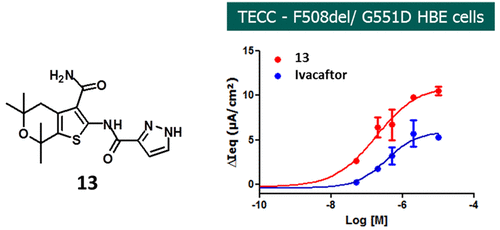当前位置:
X-MOL 学术
›
J. Med. Chem.
›
论文详情
Our official English website, www.x-mol.net, welcomes your
feedback! (Note: you will need to create a separate account there.)
Discovery of N-(3-Carbamoyl-5,5,7,7-tetramethyl-5,7-dihydro-4H-thieno[2,3-c]pyran-2-yl)-lH-pyrazole-5-carboxamide (GLPG1837), a Novel Potentiator Which Can Open Class III Mutant Cystic Fibrosis Transmembrane Conductance Regulator (CFTR) Channels to a High Extent
Journal of Medicinal Chemistry ( IF 6.8 ) Pub Date : 2018-01-10 00:00:00 , DOI: 10.1021/acs.jmedchem.7b01288 Steven E. Van der Plas 1 , Hans Kelgtermans 1 , Tom De Munck 1 , Sébastien L. X. Martina 1 , Sébastien Dropsit 1 , Evelyne Quinton 1 , Ann De Blieck 1 , Caroline Joannesse 1 , Linda Tomaskovic 2 , Mia Jans 1 , Thierry Christophe 1 , Ellen van der Aar 1 , Monica Borgonovi 3 , Luc Nelles 1 , Maarten Gees 1 , Pieter Stouten 1 , Jan Van Der Schueren 1 , Oscar Mammoliti 1 , Katja Conrath 1 , Martin Andrews 1
Journal of Medicinal Chemistry ( IF 6.8 ) Pub Date : 2018-01-10 00:00:00 , DOI: 10.1021/acs.jmedchem.7b01288 Steven E. Van der Plas 1 , Hans Kelgtermans 1 , Tom De Munck 1 , Sébastien L. X. Martina 1 , Sébastien Dropsit 1 , Evelyne Quinton 1 , Ann De Blieck 1 , Caroline Joannesse 1 , Linda Tomaskovic 2 , Mia Jans 1 , Thierry Christophe 1 , Ellen van der Aar 1 , Monica Borgonovi 3 , Luc Nelles 1 , Maarten Gees 1 , Pieter Stouten 1 , Jan Van Der Schueren 1 , Oscar Mammoliti 1 , Katja Conrath 1 , Martin Andrews 1
Affiliation

|
Cystic fibrosis (CF) is caused by mutations in the gene for the cystic fibrosis transmembrane conductance regulator (CFTR). With the discovery of Ivacaftor and Orkambi, it has been shown that CFTR function can be partially restored by administering one or more small molecules. These molecules aim at either enhancing the amount of CFTR on the cell surface (correctors) or at improving the gating function of the CFTR channel (potentiators). Here we describe the discovery of a novel potentiator GLPG1837, which shows enhanced efficacy on CFTR mutants harboring class III mutations compared to Ivacaftor, the first marketed potentiator. The optimization of potency, efficacy, and pharmacokinetic profile will be described.
中文翻译:

的发现ñ - (3-氨甲酰基- 5,5,7,7-四甲基-5,7-二氢-4- ħ -噻吩并[2,3- c ^ ]吡喃-2-基)-1- ħ吡唑-5-羧酰胺(GLPG1837),一种新型的增效剂,可以将III类突变性囊性纤维化跨膜电导调节剂(CFTR)通道打开到很高的程度
囊性纤维化(CF)是由囊性纤维化跨膜电导调节器(CFTR)的基因突变引起的。随着Ivacaftor和Orkambi的发现,已经表明通过施用一种或多种小分子可以部分恢复CFTR功能。这些分子旨在增强细胞表面CFTR的量(校正剂)或改善CFTR通道的门控功能(增强剂)。在这里,我们描述了一种新型增强剂GLPG1837的发现,与第一个上市的增强剂Ivacaftor相比,该增强剂对具有III类突变的CFTR突变体显示出更高的功效。将描述效能,功效和药代动力学特性的优化。
更新日期:2018-01-10
中文翻译:

的发现ñ - (3-氨甲酰基- 5,5,7,7-四甲基-5,7-二氢-4- ħ -噻吩并[2,3- c ^ ]吡喃-2-基)-1- ħ吡唑-5-羧酰胺(GLPG1837),一种新型的增效剂,可以将III类突变性囊性纤维化跨膜电导调节剂(CFTR)通道打开到很高的程度
囊性纤维化(CF)是由囊性纤维化跨膜电导调节器(CFTR)的基因突变引起的。随着Ivacaftor和Orkambi的发现,已经表明通过施用一种或多种小分子可以部分恢复CFTR功能。这些分子旨在增强细胞表面CFTR的量(校正剂)或改善CFTR通道的门控功能(增强剂)。在这里,我们描述了一种新型增强剂GLPG1837的发现,与第一个上市的增强剂Ivacaftor相比,该增强剂对具有III类突变的CFTR突变体显示出更高的功效。将描述效能,功效和药代动力学特性的优化。


















































 京公网安备 11010802027423号
京公网安备 11010802027423号